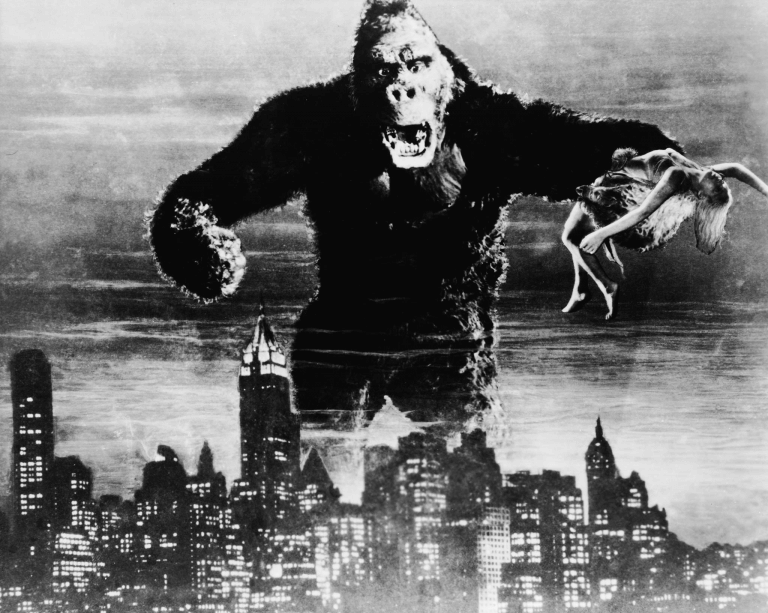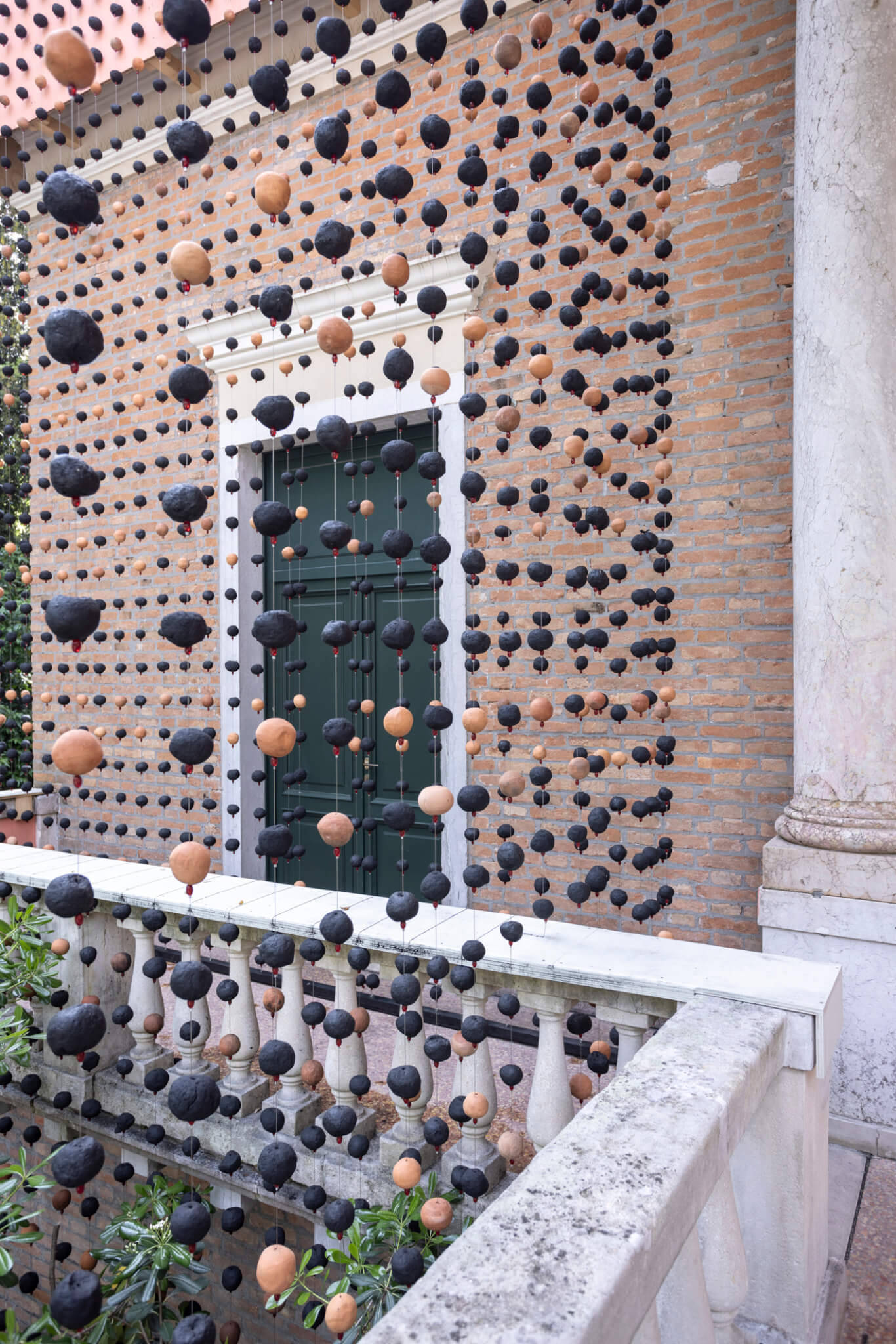Architects have long dressed up as buildings, but what about buildings in costume? From temporary art installations a la Christo and Jeanne-Claude to larger-than-life publicity stunts and brand activations shrouded as scaffolding—plus spooky moments from architecture history to wartime survival—buildings at times are altered to engage in acts of trickery.
In the spirit of Halloween, AN rounds up buildings from around the world dressed in temporary disguises. The only question we have is: Trick or treat?
Creative Brand Activation
Last Halloween, AN shared photos of the under-construction Louis Vuitton store on 57th Street. To hide the renovation work and scaffolding, the building was covered in a wrap that disguises it as a stack of Louis Vuitton trunks. Today, the fake luggage display still lures people to what is really just a construction site. What comes next might be of interest: LVMH recently submitted plans to demolish its 20-story building and replace it with a new 25-story tower. Any bets on who designed it?
In a similar vein, to cover facade work on its Oxford Street location in London, IKEA plastered a big billboard emblazoned with its signature blue bag onto the storefront. The big bag had the same tarp-like texture as the shopping-accessory-turned-fashion-statement, it even had the straps which casually hung from its top seam, just like the real thing.
Art at Work
Artists Christo and Jeanne-Claude made headlines for many decades of their career for their installations that draped well-known buildings and monuments in cities around the world. When they lived in Paris they had a vision to “wrap a public building.” They went on to make a collage that imagined the Arc de Triomphe entirely covered over, 60 years later in 2021, that project was actually realized. In a 2017 essay Matthias Koddenberg called Christo and Jeanne-Claude work “alternative architecture.” Across their career, the pair wrapped a number of buildings with memorable results, like Berlin’s Reichstag, an idea which was proposed in the 1970s but only realized in 1995.
At the Barbican Center, an exhibition staged last spring on textiles, gracefully concealed the Brutalist’s building concrete volumes with a fabric covering courtesy of artist Ibrahim Mahama. The site-specific installation dressed the building in 100 batakaris, the robes worn by Northern Ghanaian royals and Ghanaian people. The artist worked with hundreds of craftspeople in Ghana who helped sew and tailor the outfit to the Barbican’s voluptuous concrete columns and forms.

Public artists also create spooky installations. When it comes to buildings, the work of artist Alex Chinneck makes passersby second guess what they just saw. Chinneck’s craft has made a Milan building appear as if its elevation is being unzipped and he pulled a similar stunt on an office building in southeast England. More recently the master of illusion reconstructed a Georgian facade into a thin, wavy form.


Star of the Show
For those trick-or-treating or attending a Halloween costume party, movies and pop culture are often an inspiration for the evening’s look. Buildings have looked to the big screens too for stagings that replicate made-for-TV moments. A quintessential one: King Kong grasping the spire of the Empire State Building. In 1983, to commemorate the 50th anniversary of the film, owners of the art deco skyscraper placed an 84-foot-tall inflatable replica of the gorilla on the building.
More recently, in a King Kong–style homage, a 270-foot inflatable dragon, tail and all, dressed the tip of the building in a creative marketing ploy for House of Dragon.
Wartime Coverage
Buildings are also dressed up for more existential reasons. During World War I, a faux Paris was constructed 15 miles upriver on the Seine to distract bombing pilots from the real Paris. The fake one had reproductions of the Arc de Triomphe and the Champs-Élysées and even had dim lights. (Electrical engineer Fernand Jacopozzi, who lit the real Eiffel Tower, was hired to help.) Only part of the alt-Paris was built.
During World War II, this practice of urban distraction happened around the world, from England to Japan. American factories concealed their expansive interiors with roof coverings that disguised the buildings as residential neighborhoods. Boeing’s Plant No. 2 was covered with a diagonal grid of suburban houses. The buildings were short, only about 4 feet tall, and covered the 26 acres of the plant’s footprint. “The ground was made of burlap, canvas and chicken wire, while the lawns and trees were chicken feathers and spun glass,” according to the Seattle Times. Other U.S. factories were covered, like the Lockheed plant in Burbank, California.

Biennale Bombast
Lately architects have gotten creative with their national pavilions for the Biennale Architettura in Venice. This year, Estonia’s offering, curated by Keiti Lige, Elina Liiva, and Helena Männa, overclad a “historic palazzetto” with insulated panels to explore “whether insulation practices are merely a box-ticking exercise to meet European targets or if they could serve as an opportunity to address social and spatial challenges.” Also this year, the British pavilion, under the theme of Geology of British Repair, was draped with a beaded curtain (“Double Vision”) that references traditional manyatta dwellings from Kenya’s Maasai people. Nearby, Living With/Vivre Avec from France, designed by Jakob+MacFarlane, extends scaffolding to create an exterior exhibition space while the main building undergoes restoration.
In recent years, U.S. contributions have dressed up its neoclassical pavilion. Currently, PORCH: An Architecture of Generosity is on view, with a porch that provides a spot for respite and gathering. (Join AN on November 17 for an afternoon live broadcast about its contents.) In 2021, American Framing built a tall, sharp, wood structure in front of the pavilion to showcase the beauty of wood-frame construction. And in 2022, Simone Leigh’s art exhibition transformed the building with a thatched-roof portico into something that resembled a West African palace.

Scaffolding
The requirement of the Facade Safety and Inspection Program to have exterior walls inspected every 5 years has led to the proliferation of long-term scaffolding that cloaks buildings in an outer layer of inspection attire. Its prevalence gives buildings a ghastly, mummy-like appearance in which facades are covered in gauzy scrim, which was the inspiration for a photo series by Leonid Furmansky that AN published in 2022. Maybe NYC mayoral candidate Zohran Mamdani will do something to change this veiled condition?
The Ghost of Mies
As an apprentice to Peter Behrens, a young Mies van der Rohe worked on the design of a house for the Kröller family in the Netherlands. It didn’t happen, but the matriarch invited Mies to submit his own version. He lived in The Hague for a year to work on the project, and eventually a 1:1 model of the neoclassical residence was built out of wood and canvas. (The MoMA catalogue from his 1947 show called it “Schinkelesque.”) The project was never built, so all that remains is one ghostly image of the actual-size model. Rem Koolhaas imagined Mies “inside the colossal volume, a cubic tent vastly lighter and more suggestive than the somber and classical architecture it attempted to embody.” (See pages 62–63 of S,M,L,XL!) Koolhaas wondered: “Did the canvas house lead to the curtain wall?” We wonder: Is modernism, like, haunted?
This precedent also set the stage for a series of Miesian reconstructions over the years. A clubhouse Mies drew up in the 1930s was later realized in 2013 at 1:1 scale by Robbrecht en Daem architecten. At the architect’s Barcelona Pavilion, a recent installation reverted the flat-roofed structure to a model state, covering up its signature travertine and marble walls slabs of white board. Kinda ghostly, right? Mies worked on the design for a number of courtyard houses that were never built, so the exhibition LIVING Modernity: Experiments in the Exceptional and Everyday 1920s-1970s, on view earlier this year in Japan, brought the design for his Row House from 1931 to life, translating from paper into 3D form. The installation was then staged with Mies-design furniture.
The @whitehouse is getting ready for Halloween 🎃 pic.twitter.com/J7LAs6hqfl
— Office of the First Lady (@FirstLadyOffice) October 28, 2025
In Our Nation’s Capital
While the office of the First Lady was torn down last week during the demolition of the White House’s East Wing, Melania Trump and her staffers have been busy picking pumpkins and hanging fake leaves from the rounded portico of the People’s House. Perhaps the White House could take pointers from Louis Vuitton, which is blocks from Trump Tower in New York, on how to dress up the gaping hole left by the unapproved removal. One can only hope that the spirits of past East Wing workers might linger to cause trouble in whatever new ballroom that might be built on site.
→ Continue reading at The Architect's Newspaper
